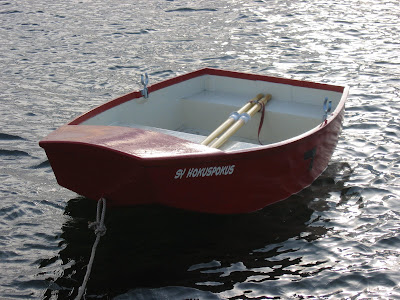I need a new dinghy. Playwood, not rubber or so. And besides, I want to gain in experience working with epoxi and plywood and stitch and glue boatbuilding. As there is bigger projects to come. Soon soon.
So what design should I take?
First I thout about a free plan from the german magazin PALSTEK wich can be found on there webside. 8' long, it is a pretty heavy construction, about 50 KG/100 lbs. - too much to lift it on board or carry it over a beach alone.
So my focus came on the CRAYFISH designed by Richard Woods sailingcatamarans.com.
Looks a bit like an optimist dinghy, the one Richard build was only 30 lbs.!
Got the plans - should be a fast thing to do. Needs anly 2 ½ sheets of 4mm BWP plywood (the german equivalet for BWP is AW100), some timber, epoxi and glass tape.
I found a good epoxi dealer about 20 Km from home, bootsservice-behnke.de, who sells everything necessary for a very resonabe price (forget West System, but buy their book THE GOUGEON BROTHERS ON BOAT CONSTRUCTION - the best book on the marked).
Today I'll get the wood.
Ich brauche ein neues Beiboot. Und habe noch keine Erfahrungen in der Verarbeitung mit Epoxidharzen. Was liegt also näher, als ein kleines Ruderboot selber zu bauen?
Nachdem ich mir den kostenlosen Plan von der Zeitschrift PALSTEK angeschaut hatte, schied der schon mal aus. Sicher kein schlechtes Boot, aber so eine Art Panzerkreuzer, wiegt vermutlich 50 Kg. Viel Spaß dabei, das Ding (äh Dinghy) mal alleine an Bord einer Segelyacht zu heben...
Daher habe ich nun einen Plan von R. Woods Sailingcatamarans genommen:
Crayfish, 2,40 m lang und von der Form sieht es aus wie eine Optimist-Jolle.
Epoxid ist günstig über Bootsservice-Behnke zu beziehen, die sind gleich bei mir um die Ecke.
Jetzt nur noch Sperrholz besorgen – und es kann los gehen!
 Behind my 26' cat "Hokuspokus".
Behind my 26' cat "Hokuspokus". First repairs allready necessary - due to bad plywood ??
First repairs allready necessary - due to bad plywood ?? First time to water - not named yet.
First time to water - not named yet.




